Even though we are no longer in lock down Covid has not gone away and as the young are partying like mad the numbers contacting the virus have shot back up and along with it the fear and shaming of people who go abroad for a holiday even though most EU countries have lower Covid figures than Ireland .
August has been wet , gardens are semi flooded , lawn mowers have been idle and Autumn has come quickly with falling leaves everywhere .
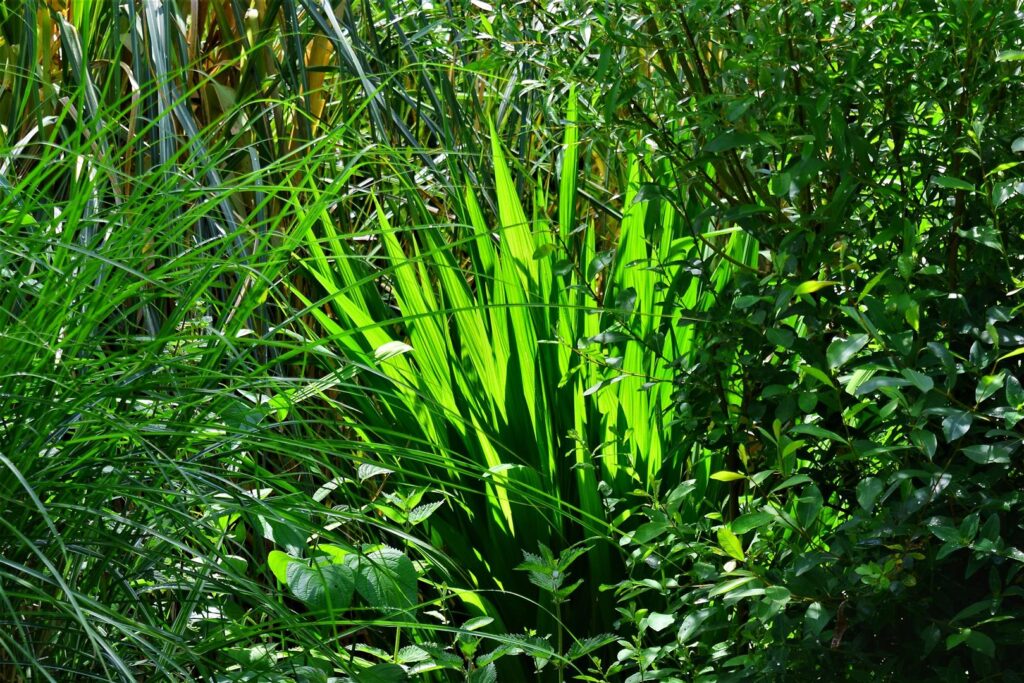

One of my favourite garden writers , Stephen Lacy , in a recent article titled “A fresh pair of eyes on your garden can throw up new ideas … if you can handle the criticism ” , praised the input of various friends visiting his garden over the years and I can agree completely that visitors to the garden can have a distinct influence . Most gardeners of course will be too polite to comment on someone else’s garden unless invited and over the years I have always valued an honest critique of our garden and before embarking on any radical change such as when we put in two new paths through the top field I always ask a few gardening friends to have a look at the plan as well of course with sounding out Snezana’s view and vice versa as she came up with our last project in the front garden our so called “Covid Wall ” in April and ran it by me for input and possible tweaking .

The most famous opinion when asked was given to Harold Nicholson back in the 1930’s when he asked the foremost garden designer of the day , Sir Edwin Luytyns , what he would do if it was his garden … his reply was short and to the point … Move !!
Good advice when you consider that Harold Nicholson with his wife , Vita Sackville West , went on to create in their next garden probably the most famous garden in the world at Sissinghurst which has a particular reverence for UK gardeners most likely because of the general fascination that the private lives of it’s creators , Vita Sackville West and Harold Nicholson , hold for the British public while also in the UK there is a nostalgia for the pre war years of the 1930’s .
As an Irish gardener the private lives of Vita and Harold mean very little and I just regard Sissinghurst as a nice garden to visit with a great National Trust café for a cream tea and while personally I consider it a lovely garden I far prefer the gardens at Inveruwe and Hidcote and I absolutely love the gardens at Rudyard Kipling’s , Batemans and Winston Churchill’s garden at Chartwell and if you are interested Tim Richardson , one of the best garden writers has just this month published Sissinghurst : The Dream Garden .
Perhaps my comment about Sissinghurst and enjoying it for it’s cream tea is a bit harsh but believe me when you are on a 2000 Km. bike trip with nothing but a cabbage leaf inside your cycling shorts between the saddle and your bum , a cream tea and a break is very important ! The cabbage leave inside the shorts is an old Irish cycling trick that works and my Mam who never drove a car but cycled all her life taught me that one … you are welcome !

I spent a day at Sissinghurst in the early 1980’s while touring Southern England on a bike and while it has a reputation as the most famous garden in the world it bears little resemblance today to when Vita and Harold designed and laid it out as the National Trust who took it over has updated the planting on a regular basis and successive Head Gardeners there have brought their own ideas . Last year I met Troy Scott -Smith at the Carlow Garden Festival and he described a project he started five years ago as Head Gardener and which will open this year called the Delos Project named after a visit by Vita and Harold to the sacred Greek island of Delos in the 1930’s where they tried to replicate the classical ruins in an area of Sissinghurst .

During his lecture that day in Carlow Scott – Smith showed photos of the work in progress and to be honest I thought it would have worked better in a more secluded area of the garden where one could imagine being back in ancient Greece and it would be difficult to evoke that atmosphere so close to the main red brick Tudor main house of Sissinghurst .
The gardening world’s response so far has been muted as can be seen in recent media statements
The National Trust’s response was measured: “we’re sorry that this hasn’t appealed to everyone. It’s a work in progress at the moment but we’ll be continuing to add plants during the spring with the full opening later on this year. We hope you’ll take a look when Delos is open and let us know what you think of the finished article.”
Another writer commented “There’s no doubt that Delos in its new form will look wonderful very soon. I’d have no concerns if it had been done almost anywhere else, but with the iconic red brick walls of the castle behind it I suppose my concern is whether it will “fit” in the longer term. But the National Trust and its gardening team at Sissinghurst deserve credit for trying to recapture the spirit of Harold and Vita’s garden and keep it changing and developing. The new Delos has a definite element of surprise which is surely key to great gardens and I think Harold and Vita would be pleased with the result. After all as Vita said: “The most noteworthy thing about gardeners is that they are always optimistic, always enterprising and never satisfied. They always look forward to doing something better than they have ever done before.”
Another reviewer commented “There’s no doubt it’s shocking, and in its present immature state at odds with the rest of the garden. But I think of my own gravel garden and know that once the plants assert themselves and spread and self-seed the starkness will soften almost overnight, the rock will acquire a patina and the shock of the new will become just a familiar difference. Would I have done the same thing? I’m honestly not sure. Am I glad the National Trust did it? I think on balance it was worth the risk .”
Dan Pearson , probably the most famous garden designer in the world right now was brought in as consultant on the Delos project at Sissinghurst as he had worked with huge natural stone on his design for a rock installation at Chatsworth House which won him a gold medal and Best in Show Garden at Chelsea in 2015 and if you want to see how to use large stone in a garden setting I would recommend looking at his web site at http://danpearsonstudio.com/chatsworth-laurent-perrier/ .
This gold medal garden is of course garden design on a huge multi million euro budget but most of us with the space can use large stone on a more humble budget and currently I am working on a project for the garden here with stone sourced from a neighbours land on the hill side opposite us … this is in an area I always felt needed something extra and my first idea was for an island bed of mixed perennials and small shrubs but decided against so now the plan is for three or four large rocks on a bed of gravel and this month I have cut out the design in a tear drop shape , sprayed off the grass and hopefully we will be ready to install in late September .

In our garden here there has been an area of the woodland bordering on to the stream which we never did anything with as it was boggy and water logged and taken over and choked with huge brambles , an area we never went into and kind of forgot about until this month when I took a closer look at it and fought my way right into the edge of the stream where I saw that there was a nice collection of self seeded silver birch trees and clumps of thussock grass all happily thriving in the damp conditions and in total anonymity away from view … possibilities possibilities as Capability Brown famously said in the mid 18th century !

Peter Cullen arrived with his excavator and was given the brief to clear all the brambles and woody materials and then he and I would decide how to proceed from a clean palette – my original idea had been to sow a rough lawn through the trees to the water’s edge however we both saw that as he excavated the soil it just as quickly filled up with water that was obviously just under the surface so forgetting any thoughts of a lawn we decided to enhance the water and keep digging backwards until we hit dry ground and in a few hours Peter had created a small pond about a metre deep . The excavated wet soil was laid along the banks of the new water area and will provide the ideal planting habitat next spring for hostas , darmeras , ligularia , primulas and other plants that like boggy conditions .

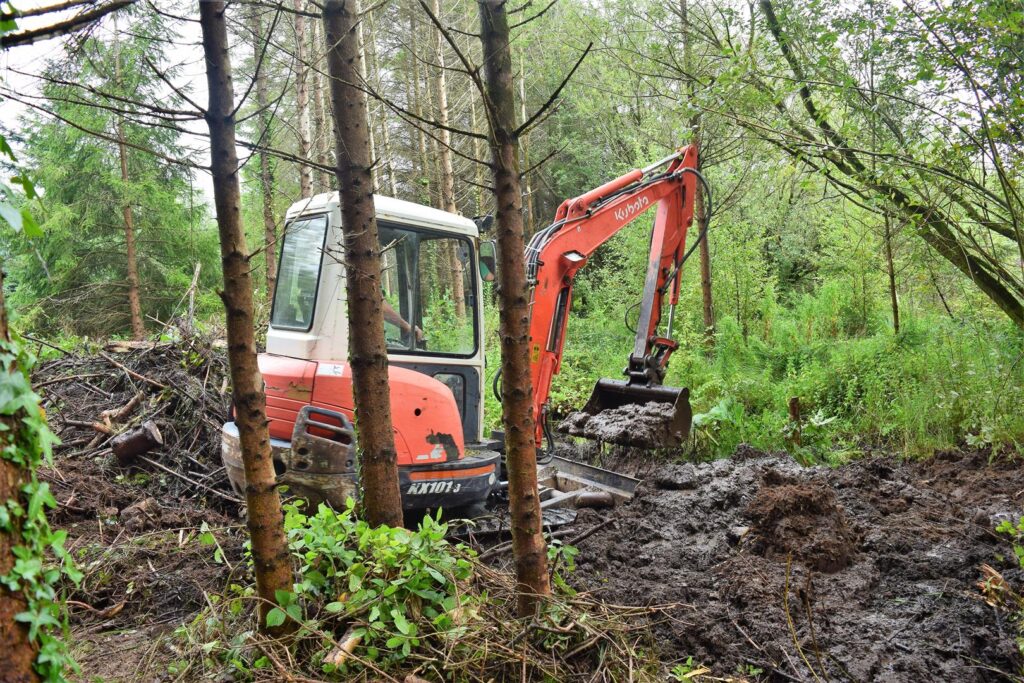
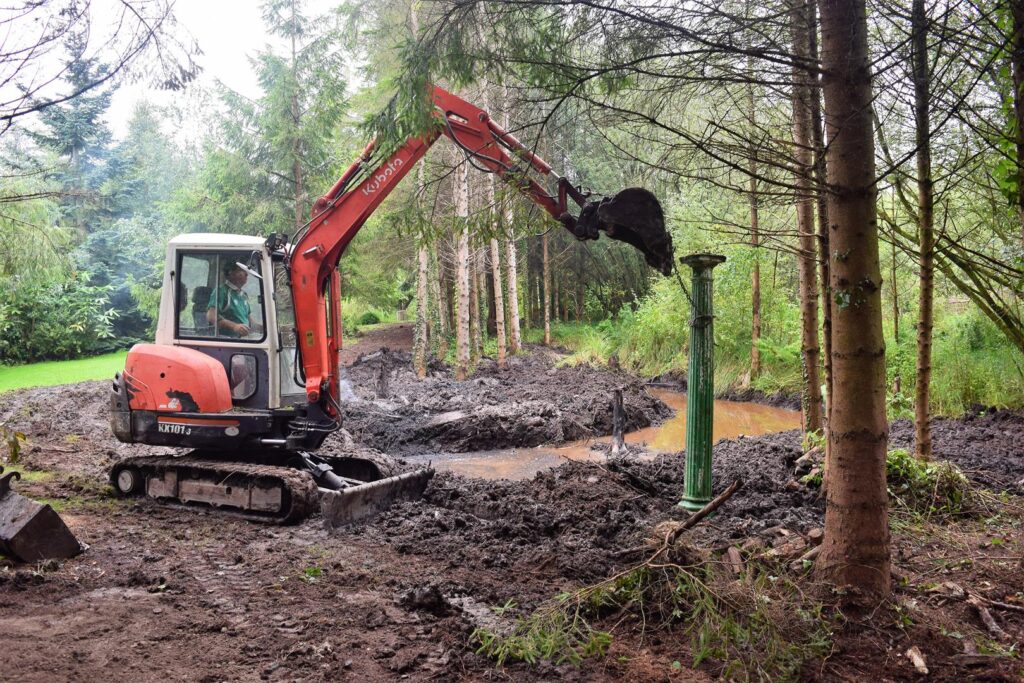

I spent the next two weeks cleaning up the reclaimed ground between the trees , stripping the ivy off the trees and my next task will be to wade into the boggy ground between this new area and the stream and clean it up with a strimmer and then assess what planting it will allow between the self seeded silver birch that have colonised the area while naturally I will retain all the silver birch in situ and work around and through them .
Ivy on trees has never bothered me up to this year and while I know ivy doesen’t damage healthy trees I now prefer a cleaner look in the woodland area and have stripped off all the conifers in the new area .
And on the subject of ivy, a leading article in last weekend London Times ran a headline “Ivy hailed as nature’s thermostat rather than a creep ” as the Royal Horticultural Society has now endorsed as official policy that ivy is not merely decorative on buildings but is good for regulating temperature and humidity . The RHS conducted an experiment with the University of Reading and published the results in the journal Building and Environment where it was found that ivy reduced temperature within the trialled buildings by 7.2 deg. in summer and kept them warmer by 2.2 deg. in winter . The ivy referred to here is not the heavy common ground ivy which I definitely would not let anywhere near a wall but the specialist climbing ivies , hedera helix and virginia creeper , parthenocissus tricuspidata , which are less a thug and easy to remove and the study also recommended the climbing hydrangea , pileostegia viburnoides although this is not as good as the ivy .
Bosnian memories
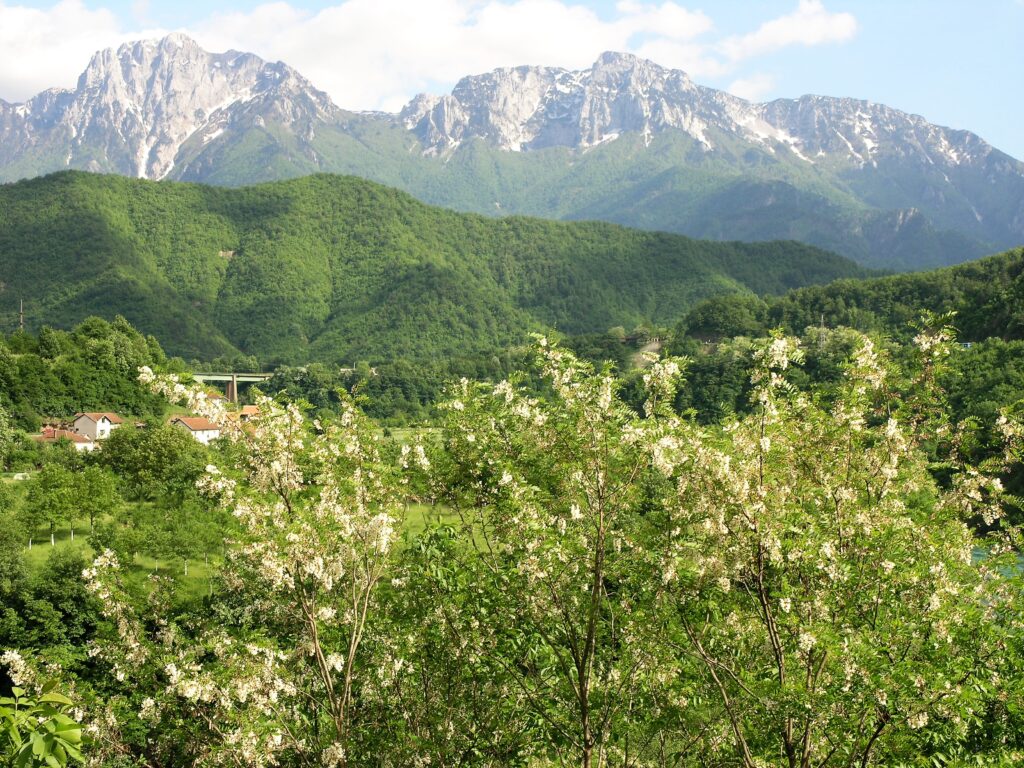
In 1997 as the EU representative assigned to the Bosnian State Boundary Commission one of my first roles was to oversee the planned resumption of commercial traffic across the northern border with Croatia in an effort to jump start the Bosnian economy and reopen trade routes . The big problem in 1997 was that there were no roads open across that border which for it’s entire length of over 600 Km. is the Sava river and being a river frontier you needed bridges of which pre war there were nine however at the outbreak of war in 1991 all these bridges were blown up by local militia at each location to stop either the Croat , Serb or Muslim armies crossing the river as was the case with the Croats invading Bosnia or the Serbs attacking across into Croatia .
The EU and World Bank had funding in place to begin construction of the nine bridges in 1997 and the US Army were there in force to plan and support this and I was seconded to advise on the traffic categorisation of each location and on any other issues that might impede the reconstruction .
You would think funding of approx. 20 million euros is in place for each bridge … get the builders in … bridge built …job done … but this being Bosnia it was not as uncomplicated as that because bridges provide communication between communities on both sides and these communities had only recently stopped killing each other after four years of war while another complication more difficult to solve was that a new bridge would facilitate the return of a flood of refugees who had been ethnically cleansed from both sides of the Sava river . The refugee’s original houses had for the past five years been occupied by refugees from other parts of both Bosnia and Croatia during the war and they were in no hurry to go back to their original homes as in most cases their original houses were blown up and unless you had a large majority of your own people also moving back you wouldn’t be safe .
So when a new bridge was proposed for say Bosanski Brod the Serbs living on the Bosnian side of the Sava knew that there would be huge amount of Bosnian Croats lined up to cross the bridge from Croatia to reclaim their houses while down the river at Novi Grad it would be the opposite with Bosnian Serbs travelling across into Croatia to reclaim their property .
US Army intelligence who would serve in Bosnia from their bases in North Bosnia would pick up regular threats to blow up the bridges again from nationalist extremists from all sides as these elements wanted the segregated and separated status quo in Bosnia to remain . As I said a complicated situation and frustrating for the International Community who just wanted to have Bosnia functioning as a normal society again and couldn’t understand why the nationalist political parties couldn’t agree to this but again you have to remember that this was just two years after a major four year civil war with huge civilian casualties where a 600 year history of religious hatred had resurfaced .
Only one of the Sava bridges was relatively easy , at Orasje and this because it was a Croat population on both sides of the river with no refugees pressing to return but even here there were threats to blow up the bridge right up to the day of the official opening as the local Croat mafia who ran and collected revenue from a temporary ferry crossing at the location wanted to preserve the lucrative revenue and bribery opportunities from the ferry .
Witnessing the results of war and fleeing refugees nothing prepares you for people fleeing destruction with all they can carry in either a battered pick up or on a trailer behind a tractor or in some cases when I was present at the Serbian border and saw Serb men carrying their grandparents in wheel barrows fleeing the Krajina region with the advancing Croatian Army just a mile behind them in August 1995 … throughout the war the fleeing victims could be Serbs, Croats or Muslims , take your pick depending on the location .
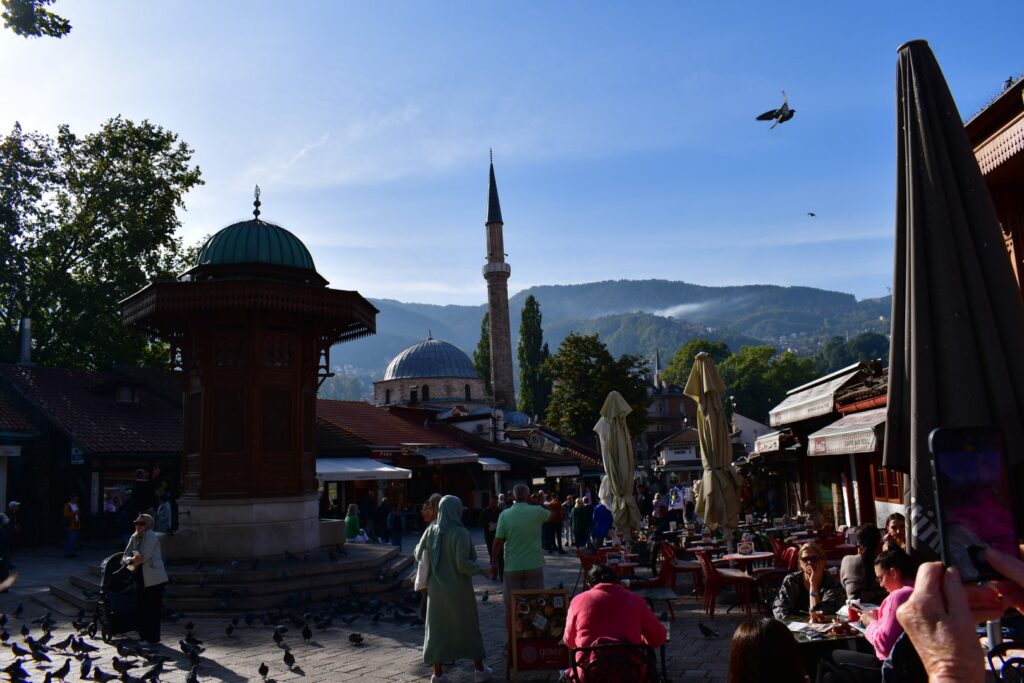
In the immediate post war Bosnia I always felt safe with the Bosnian people be they Serb , Croat or Muslim as I was always met with unfailing courtesy and hospitality but of course it helped that I loved being there and appreciated the company of Yugoslav people , knew what each group had gone through in the recent wars , knew the history of the Balkans going back to the Ottoman conquest in the 15th century and that above all that I loved the culture .
Of course there were tense moments when I would by accident have ended up in demonstrations or got caught in cross fire between rival groups as happened once in Mostar when Bosnian Croats and Bosnian Muslims squared up to each other after a funeral and once I was targeted by nationalistic hard line Serbs unhappy with a multi ethnic recruitment policy I was pushing in a customs administration in Brcko , NE Bosnia where they thought I was bringing back too many Muslims .

In the first six months after the war ended in Bosnia there were several stretches of road corridoors where travel was only allowed in day light and then you were advised to join a convoy of vehicles as car hijacking was common on a daily basis and we had instructions to carry money in our shoes , our passports on our person and hand over the keys immediately if ordered to . Then there were the local militia check points manned by armed irregulars which could spring up anywhere where they blocked the road with a string of seven or eight anti tank land mines all tied to one long rope which was casually pulled back to allow you through , these unofficial road blocks were always tense as these guys were not trained professional soldiers and were usually nervous themselves and you hope the mines don’t hit a bump as they are yanked back .


Favourite Balkan country I worked in would have to be Bosnia where I spent ten years but Macedonia was my first foreign assignment and my two years there were special as it was my first contact with the culture of the Balkans , the people , the food , the unforgettable scenery and like all first loves Macedonia will always hold a special status for me . I have worked and lived in all the major Balkan capitals , Skopje , Belgrade , Sarajevo ,Zagreb , Pristina, Mostar but Skopje where I lived for two years has a special ambience and would be my favourite city but Sarajevo runs it a close second .




Leave a Reply